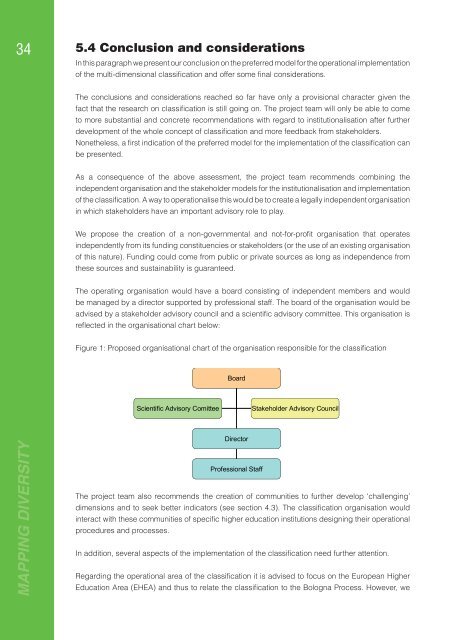Mapping Diversity: Developing a European Classification of ... - U-Map
Mapping Diversity: Developing a European Classification of ... - U-Map
Mapping Diversity: Developing a European Classification of ... - U-Map
Create successful ePaper yourself
Turn your PDF publications into a flip-book with our unique Google optimized e-Paper software.
34 5.4 Conclusion and considerations<br />
In this paragraph we present our conclusion on the preferred model for the operational implementation<br />
<strong>of</strong> the multi-dimensional classifi cation and <strong>of</strong>fer some fi nal considerations.<br />
The conclusions and considerations reached so far have only a provisional character given the<br />
fact that the research on classifi cation is still going on. The project team will only be able to come<br />
to more substantial and concrete recommendations with regard to institutionalisation after further<br />
development <strong>of</strong> the whole concept <strong>of</strong> classifi cation and more feedback from stakeholders.<br />
Nonetheless, a fi rst indication <strong>of</strong> the preferred model for the implementation <strong>of</strong> the classifi cation can<br />
be presented.<br />
As a consequence <strong>of</strong> the above assessment, the project team recommends combining the<br />
independent organisation and the stakeholder models for the institutionalisation and implementation<br />
<strong>of</strong> the classifi cation. A way to operationalise this would be to create a legally independent organisation<br />
in which stakeholders have an important advisory role to play.<br />
We propose the creation <strong>of</strong> a non-governmental and not-for-pr<strong>of</strong>i t organisation that operates<br />
independently from its funding constituencies or stakeholders (or the use <strong>of</strong> an existing organisation<br />
<strong>of</strong> this nature). Funding could come from public or private sources as long as independence from<br />
these sources and sustainability is guaranteed.<br />
The operating organisation would have a board consisting <strong>of</strong> independent members and would<br />
be managed by a director supported by pr<strong>of</strong>essional staff. The board <strong>of</strong> the organisation would be<br />
advised by a stakeholder advisory council and a scientifi c advisory committee. This organisation is<br />
refl ected in the organisational chart below:<br />
Figure 1: Proposed organisational chart <strong>of</strong> the organisation responsible for the classifi cation<br />
Board<br />
Scientific Advisory Comittee<br />
Stakeholder Advisory Council<br />
MAPPING DIVERSITY<br />
Director<br />
Pr<strong>of</strong>essional Staff<br />
The project team also recommends the creation <strong>of</strong> communities to further develop ‘challenging’<br />
dimensions and to seek better indicators (see section 4.3). The classifi cation organisation would<br />
interact with these communities <strong>of</strong> specifi c higher education institutions designing their operational<br />
procedures and processes.<br />
In addition, several aspects <strong>of</strong> the implementation <strong>of</strong> the classifi cation need further attention.<br />
Regarding the operational area <strong>of</strong> the classifi cation it is advised to focus on the <strong>European</strong> Higher<br />
Education Area (EHEA) and thus to relate the classifi cation to the Bologna Process. However, we

















